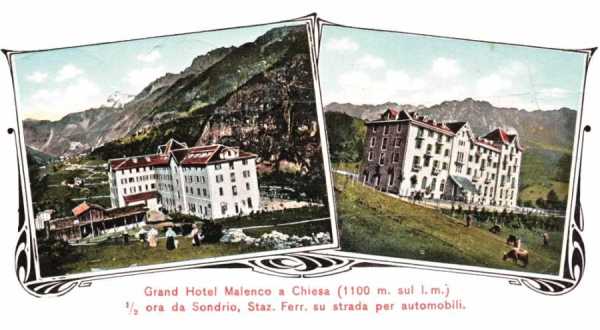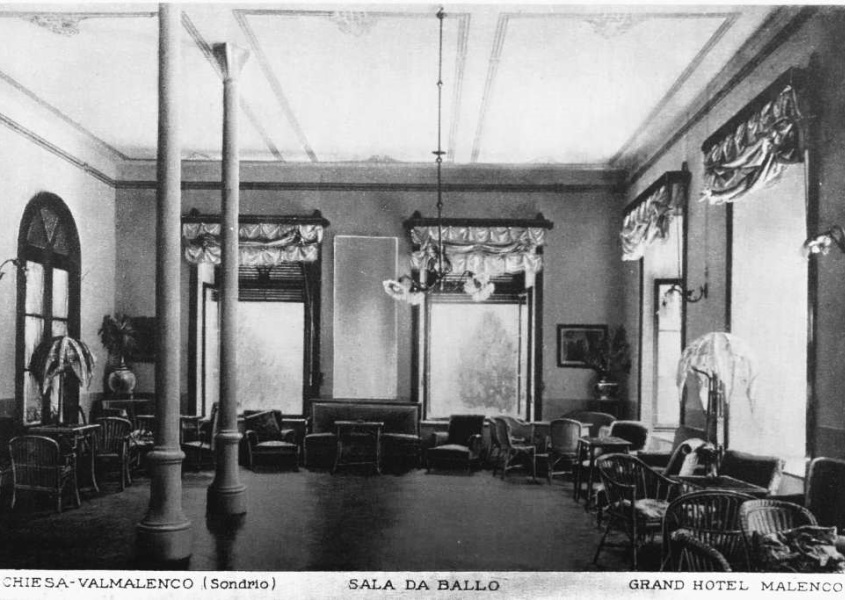 Postcard of the Grand Hotel
Postcard of the Grand Hotel
Francesco Vitali, promotor of Sondrio as an international tourist centre, for which the Valmalenco was to have been the offer for high altitude tourism, died in Sondrio in June 1903.
Together with Andrea Albonico and the lawyer Azzo Pesenti, Vitali built some delightful little houses in Chiesa in the Valmalenco, which fitted in very well with the surrounding environment.
He brought the telegraph and improved the road to the valley and also had a project in store for a rail link between the main town in the province and Engadine, which was actually supposed to pass through the Valmalenco.
In 1905, Enrico and Mario Vitali continued their father's work and built the magnificent Grand Hotel Malenco on the south east edge of Chiesa.
This was to be the heart of a large entrepreneurial project aiming to bring an elite tourism to the valley.
Externally, the building appeared rustic and immense, as though it was trying to stress the elegance and sumptuous atmosphere of the interior decoration by Battista Vitali.
The pearl of the structure was the light-filled dining room, with over 200 seats and splendid chandeliers.
It was an enormous success and new hotels and restaurants had to be built.
The town economy was given new life and vitality (Information taken from: Franco Monteforte, L'età liberty in Valtellina, Mevio Washington & Figlio, Sondrio 1988).
From the second half of the 20th century, the search for top quality was suffocated by the greed of wild construction speculation, which gradually drove away the one time rich, enthusiastic clients.
Thus, the symbol of this era was closed down and converted into apartments.
Its memory was allowed to slide into the oblivion of modernity.
In the early 20th century, the Grand Hotel Malenco was an excellent, architecturally well-balanced, stone building, which recalled the liberty style and fitted harmoniously into the surrounding environment.
Owned by Franco Sampietro, it had 180 beds and just as many staff, some of whom came from Lake Como and were employed in spring and in autumn in the hotel in Tremezzo, managed by the owner himself.
The hotel was looked after by Mr Battaglia, from Savognin (Engadine), who settled in Vassalini, where he married and had two sons, Umberto and Angelo, both carpenters.
Umberto later became the caretaker of the Grand Hotel with his wife Carolina Bagiolo and, like all craftsmen, was capable of putting his hand to anything: so, out of season he dedicated himself to little maintenance jobs.
In 1918, they adopted his wife's nephew, Aldo Bagiolo, who had lost his parents in the Spanish flu pandemic.
After attending the primary school, the latter became assistant caretaker until 1960.
In the years that followed, management was given to Bruno Cabello from the district of Sasso.
The majority of the staff came from the valley, especially from the district of Sasso.
The women took over room service, the men helped in the kitchen and saw to any manual jobs as they were needed, whereas the staff from the Como area were given the qualified jobs, such as chef, waiter, cabaret artist and gardener.
The hotel was, therefore, not only a major tourist resource which benefitted the entire valley, it was also a source of seasonal employment for many people in the valley.
It was a first class structure with every comfort: bar, café, patisserie, dairy, billiard room, tearoom, ballroom, reading room, post office, telephone, telegraph, doctor's surgery, hairdresser, gardener, baby sitter and passenger transport service between Chiesa and Sondrio, which also benefitted the people of the valley.
At first, the transport service used horse-drawn carriages, which were later replaced by motor vehicles.
Outside, the Hotel had two bowling greens and two tennis courts, a children's playground and in the area to the south, a series of little tables with deckchairs and armchairs for afternoon relaxation, all cared for and kept in order with floral displays made by gardeners, who also looked after the large, adjoining pine forest.
An adjacent guest house welcomed special clients and staff: artists, poets, musicians (noteworthy among the musicians was the pianist, Francesco Sacchi from Lecco, also composer of a few pieces of music for the CAI mountain choir of the Valmalenco, who continued to work under the Sozzani (Tato) management in the years from 1965-78),
cabaret artists, activity organisers and the priest to celebrate the religious functions in the tiny church in the district of Sasso dedicated to Saint Emilia the name of the hotel owner's wife.
Mass was celebrated at 11.00 a.m. every Sunday, when some of the young girls from Cagnoletti sold bunches of cyclamens to the guests staying there.
Further down the valley, a large ground floor building served as a garage, whereas the floor above had the rooms for staff from outside the valley.
A little further down, a meadow with a stable and a barn housed the cows, which supplied the needs of the hotel.
 Hotel Lounge - Photo Comi Archive
Hotel Lounge - Photo Comi Archive
The pearl of the hotel was the large dining room, supported by columns and liberty style, stucco cornices, made by the maestri of scagliola from the valley of Intelvi.
The room also acted as a ballroom for grand gala events, contests and congresses.
Those occasions never failed to see politicians, such as Tremelloni, Togliatti and Aldo Moro, who stayed in the Gaggi house in Sasso during the 50s.
Other famous people included those who owned the villas in Sasso: Cao, Balgera and Albonico and many well-known people from the hinterland of the Valtellina.
Among the singers, I can remember the tenor, Ramelli, who was introduced by Italo Mitta, who ran the Tourist Office and who wrote about Eco delle Valli, a close collaborator of the manager, Bruno Gualzetti.
The poet, Giuseppe Nolli, friend of Erminio Dioli, described the hotel as the soul of the valley.
Mr Ezio Pavesi wrote a historic book about Torre di Santa Maria in the Valmalenco, and the impressionist painter, Polo Punzo, was dedicated to our mountains.
The hotel had large, modern, coal and wood cookers, equipped with copper pots, which had to be frequently polished and re-covered, so as not to leave posionous residues.
Top chefs organised the work in the kitchen and they also employed the tinsmiths (magnàn) of Lanzada.
We should also spare a thought for the last of the craftsmen, Alessandro Rossi, father of Don Alfonso, already working from 1947; from then on, he was not only an excellent tinsmith, but was also jack of all trades in the kitchen until the hotel closed in 1978.
He was the first to open the kitchen in the morning to clean and polish the copper pots, the silver cutlery and trays.
At the end of the season, he boiled all the silver in ash to return it to its natural splendour and guarantee greater hygiene.
In addition, he was also in charge of the fishmonger's: he took the fresh fish from the tank or the preserved fish from the cellar.
There were, in fact, some very deep cellars with long corridors, along which the currents of air blew to preserve the food and wine, kept cool with ice throughout the winter.
To produce the ice, they had prepared a tennis court with a wooden structure holding a rotating water spray, which froze in the cold to form large sticks of ice.
These were thrown through a special door into the underground rooms, where they lasted throughout the summer season.
The operation was managed by specialised staff and was repeated each year to ensure the food intended for the kitchen was well preserved.
The Grand Hotel Malenco was the main, first-class tourist structure of the valley, accompanied by other comfortable hotels: Mitta, Amilcar, Bernina and by two restaurants opposite the post office: Posta and Dosso.
100 metres below the Hotel stood the Grand Caffè Belvedere, with a large dance hall at road level and a cinema on the floor below, managed by the Ferrari family from 1924.
It was the first in the Valmalenco.
It was very popular with the customers of the Hotel, of the Pesenti villas and from the four hotels in Torre di Santa Maria.
As children, we were very inquisitive and resourceful.
We would collect bunches of flowers or fruits from the wood to offer the ladies and gentlemen in order to receive a good tip.
At the same time, we would admire their shiny motor vehicles, enormous American or English cars.
We would also offer our help to those taking a walk in the pine forest or to the families who arrived by bus from Sondrio with heavy suitcases to get more tips.
During the dance evenings, we listened to the music and we had fun spying through the slits in the shutters on the couples as they danced the elegant Belle Époque dances.
The scene was lit with the majestic chandeliers, which shone on the women in their opulent dresses amidst the multi-coloured festoons hanging lightly from the ceiling.
Everything was in total contrast with the ordinary houses: dark, blackened by smoke and lit only by firelight or by a torch.
Only a few had a five-candle electric light.